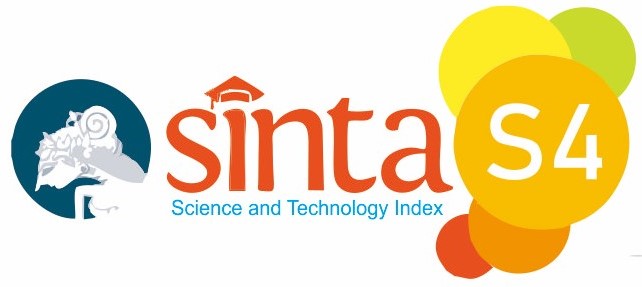ANALISA LAJU KOROSI PADUAN SENG (ZN) UNTUK APLIKASI IMPLAN TERSERAP TUBUH
Abstract
Biomaterial berkembang dengan pesat ke tahap dikemukakannya klasifikasi logan baru dikenal sebagai loganm terserap tubuh (absorbable). Besi (Fe), Magnesium (Mg), dan Seng (Zn) yang umum digunakan sebagai dasar dari paduan bioabsorbable. Zn yang belakangan ini sering diteliti karena berpotensi oesteogenik dan dapat terurai dalam tubih manusia. Zn dengan komposisi murni telah diteliti namun ditemukan memiliki sifat lunak dan memiliki sifat korosi yang lambat dinilai tidak memenuhi kebutuhan medis. Maka dikembangkanlah Zn dengan paduan Mg yang diharapakan dapat meningkatkan sifat mekanik dan sifat korosi yang sesuai terhadap proses biologis tubuh. Salah satu konsentrasi yang bagus adalah Zn-1Mg. Studi ini bertujuan untuk kontribusi analisa sifat mechanical (microhardness) dan corrosion rate (laju korosi) paduan Zn-1Mg as-rolled untuk aplikasi implan terserap tubuh. Untuk mengetahui sifat mechanical dan corrosion rate dari paduan Zn-1Mg as-rolled dilakukan secara In-Vitro. Pengujian yang dilakukan adalah microhardness Vickers, dan immersion test metode menggunakan media simulated body fluids Kokubo’s solution. Corrosion rate paduan Zn-1Mg dihitung dengan metode weight-loss. Selain itu data didukung dengan XRD dan XRF. Hasil pengujian menegaskan terjadinya penurunan microhardness seiring waktu immersion test dengan nilai 85 HV. Sedangkan. Corrosion rate paduan Zn-1Mg meningkat seiring waktu immersion test dengan corrosion rate tertinggi 0,0016 ±0,00002 mm/year. Selain itu juga ditemukan produk korosi yang menempel di permukaan spesimen uji, yang menjadi penyebab terjadinya korosi pitting. Dari hasil-hasil temuan tersebut dapat dijadikan acuan untuk pengembangan penelitian paduan Zn-1Mg as-rolled.
References
Arafat, A., Idris, M. H., Kadir, M. R. A., & Jafari, H. (2014). Characterisation of calcium phosphate coating on investment cast 316L stainless steel. 18. https://doi.org/10.1179/1432891714Z.000000000528
ASTM G1-90. (1999). ASTM G1 Standard Practice for Preparing, Cleaning, and Evaluation Corrosion Test Specimens. Astm, 8. https://www.astm.org/Database.CarT/Historical/G1-03R11.htm
ASTM G31 – 72. (2004). ASTM G31: Standard Practice for Laboratory Immersion Corrosion Testing of Metals. ASTM International, i(Reapproved), 5–7.
ASTM International. (2014). Standard Guide for Applying Statistics to Analysis of Corrosion Data. Astm, 95(Reapproved 2010), 1–14.
ASTM Standard E92-82. (1997). ASTM E92-82 Standard Test Method for Vickers Hardness of Metallic Materials. Annual Book of ASTM Standards 4, 82(Reapproved), 1–27.
Champagne, S., Mostaed, E., Safizadeh, F., Ghali, E., Vedani, M., & Hermawan, H. (2019). In vitro degradation of absorbable zinc alloys in artificial urine. Materials, 12(2), 1–13. https://doi.org/10.3390/ma12020295
Corro-, E. (2020). Standard Guide for in vitro Degradation Testing of Absorbable Metals 1. i, 1–13. https://doi.org/10.1520/F3268-18.vb
Emily Walker, M. H. (2015). Magnesium, Iron and Zinc Alloys, the Trifecta of Bioresorbable Orthopaedic and Vascular Implantation - A Review. Journal of Biotechnology & Biomaterials, 05(02). https://doi.org/10.4172/2155-952x.1000178
Exley, C., & Mold, M. J. (2015). The binding, transport and fate of aluminium in biological cells. Journal of Trace Elements in Medicine and Biology, 30, 90–95. https://doi.org/10.1016/j.jtemb.2014.11.002
Francis, A., Yang, Y., Virtanen, S., & Boccaccini, A. R. (2015). Iron and iron-based alloys for temporary cardiovascular applications. Journal of Materials Science: Materials in Medicine, 26(3), 1–16. https://doi.org/10.1007/s10856-015-5473-8
Galib, R. H., & Sharif, A. (2016). Development of Zn-Mg Alloys as a Degradable Biomaterial. Columbia International Publishing Advances in Alloys and Compounds, 1(1), 1–7. https://doi.org/10.7726/aac.2016.1001
Gong, H., Wang, K., Strich, R., & Zhou, J. G. (2015). In vitro biodegradation behavior, mechanical properties, and cytotoxicity of biodegradable Zn-Mg alloy. Journal of Biomedical Materials Research - Part B Applied Biomaterials, 103(8), 1632–1640. https://doi.org/10.1002/jbm.b.33341
Hermawan, H. (2012). Biodegradable Metals: State of the Art. 13–22. https://doi.org/10.1007/978-3-642-31170-3_2
Hernández-Escobar, D., Champagne, S., Yilmazer, H., Dikici, B., Boehlert, C. J., & Hermawan, H. (2019). Current status and perspectives of zinc-based absorbable alloys for biomedical applications. Acta Biomaterialia, 97, 1–22. https://doi.org/10.1016/j.actbio.2019.07.034
Kokubo, T., & Takadama, H. (2006). How useful is SBF in predicting in vivo bone bioactivity? Biomaterials, 27(15), 2907–2915. https://doi.org/10.1016/j.biomaterials.2006.01.017
Kubásek, J., & Vojtěch, D. (2012). Zn-based alloys as an alternative biodegradable materials. METAL 2012 - Conference Proceedings, 21st International Conference on Metallurgy and Materials, 1355–1361.
Levy, G. K., Goldman, J., & Aghion, E. (2017). The prospects of zinc as a structural material for biodegradable implants—a review paper. Metals, 7(10), 1–18. https://doi.org/10.3390/met7100402
Li, H. F., Xie, X. H., Zheng, Y. F., Cong, Y., Zhou, F. Y., Qiu, K. J., Wang, X., Chen, S. H., Huang, L., Tian, L., & Qin, L. (2015). Development of biodegradable Zn-1X binary alloys with nutrient alloying elements Mg, Ca and Sr. Scientific Reports, 5, 1–13. https://doi.org/10.1038/srep10719
Liu, X., Sun, J., Qiu, K., Yang, Y., Pu, Z., Li, L., & Zheng, Y. (2016). Effects of alloying elements (Ca and Sr) on microstructure, mechanical property and in vitro corrosion behavior of biodegradable Zn-1.5Mg alloy. Journal of Alloys and Compounds, 664, 444–452. https://doi.org/10.1016/j.jallcom.2015.10.116
Materials, M., Stainless, F., Plate, H. S., Bars, S. S., Wire, S. S., Rods, W., Products, S., & Requirements, C. (2021). Standard Guide for Metallurgical Characterization of Absorbable Metallic Materials for Medical Implants 1. i, 1–11. https://doi.org/10.1520/F3160
Mccall, K. A., Huang, C.-C., & Fierke, C. A. (2000). Zinc and Health: Current Status and Future Directions Function and Mechanism of Zinc Metalloenzymes 1. J. Nutr, 130(February), 1437–1446.
Mostaed, E., Sikora-Jasinska, M., Mostaed, A., Loffredo, S., Demir, A. G., Previtali, B., Mantovani, D., Beanland, R., & Vedani, M. (2016). Novel Zn-based alloys for biodegradable stent applications: Design, development and in vitro degradation. Journal of the Mechanical Behavior of Biomedical Materials, 60, 581–602. https://doi.org/10.1016/j.jmbbm.2016.03.018
Nanda, I. P., Hassim, M. H., Idris, M. H., Jahare, M. H., Abdulmalik, S. S., & Arafat, A. (2019). Mechanical and degradation properties of zinc adopted magnesium alloys for biomedical application. IOP Conference Series: Materials Science and Engineering, 602(1). https://doi.org/10.1088/1757-899X/602/1/012094
Olszta, M. J., Cheng, X., Jee, S. S., Kumar, R., Kim, Y. Y., Kaufman, M. J., Douglas, E. P., & Gower, L. B. (2007). Bone structure and formation: A new perspective. Materials Science and Engineering R: Reports, 58(3–5), 77–116. https://doi.org/10.1016/j.mser.2007.05.001
Thomas, S., Birbilis, N., Venkatraman, M. S., & Cole, I. S. (2012). Corrosion of zinc as a function of pH. Corrosion, 68(1), 1–9. https://doi.org/10.5006/1.3676630
Witte, F. (2019). 1.3.3D – Biodegradable Metals. In Biomaterials Science: An Introduction to Materials in Medicine (Fourth Edi). Elsevier. https://doi.org/10.1016/B978-0-12-816137-1.00021-0
Zheng, Y. F., Gu, X. N., & Witte, F. (2014). Biodegradable metals. 77, 1–34. https://doi.org/10.1016/j.mser.2014.01.001








.svg_.png)


